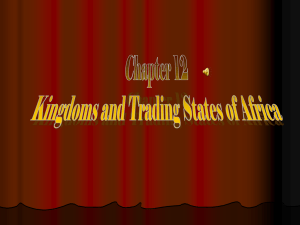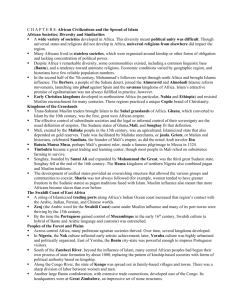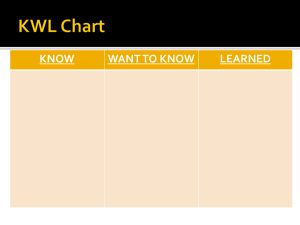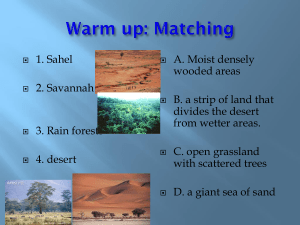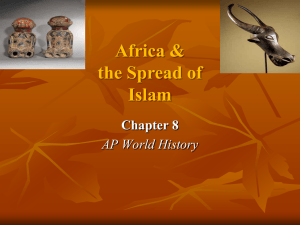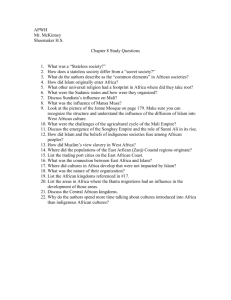Africa
advertisement
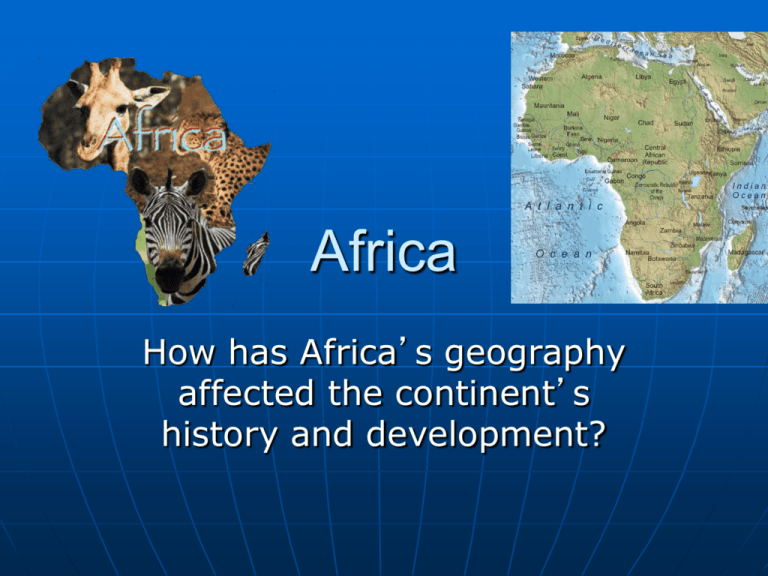
Africa How has Africa’s geography affected the continent’s history and development? Different Geographic Regions Sahara desert is the largest desert in the world. For thousands of years it has played a major role in the development of Africa. The Sahara Desert Geography Africa is the worlds’ second largest continent. It has a wide variety of climates, topography, vegetation, and terrains which have impacted the diversity of it’s cultures. The largest and most populated regions are the savannas, or grassy plains. The Green zone is the savanna Here is what you can find in Africa’s savannas… Geo=earth, graphy=study of Geo+graphy=the study of Earth’s physical features Geography affects how people live and how they make a living. Geographic features can act either as barriers or highways to the movement of people, goods, and ideas. A barrier is something that makes travel difficult or near impossible. Can you name one “geographic barrier” in Africa?” A plateau is a barrier Africa’s high plateau interior and rivers with cataracts, or waterfalls hindered easy movement. While plateaus can be a barrier, they also form amazing landmarks Victoria Falls The Great Rift Valley; a highway The Great Rift Valley served as an interior passageway and the Mediterranean and Red seas provided overseas trade routes to regions in the Middle East and Europe. Early Africa’s Economy Mineral wealth spurred trade since ancient times. Salt, gold, iron, and copper were valuable items. Trade linked Africa to other continents. Ships of the Desert By the year A.D. 200, a new form of transportation emerges, the “ships of the desert.” These were camels that could carry heavy loads and walk 20-30 miles a day in the desert without water. Checkpoint: What geographic features limited movement of people in Africa?????? •Plateaus •Deserts •Smooth Coast line •Impassable rivers •Cataracts or waterfalls. Climate Change? Back then too? Farming even spread into the Sahara desert. However, in 2500 B.C., a climate change slowly dried out the Sahara. Desertification The land became dry and the desert spread. This is known as desertification and forced people to migrate away from this area. At risk of desertification The Bantu Migrations Migrations shaped the diversity in African cultures. West African languages derived from one common language called Bantu. Bantus were good at farming, working with iron, and domesticating animals. Bantu Migrations The Bantu Legacy As they spread into Southern Africa, Bantu culture merges with new cultures. Bantu language is still spoken today. This is cultural diffusion. Checkpoint: How did migration affect the development of African cultures?????? Migration helped spread ideas and skills such as: •Farming •Ironworking •Domesticating animals Where is the Nile River? Cultural diffusion with Egyptians Nubia is controlled by Egyptians for 500 years. As a result, Nubians adapt Egyptian culture. In 500 B.C., Nubia is threatened by the Assyrians from SW Asia (Middle East). Nubians are forced to move their capital to Meroe. Why are rivers so important to people in history? Controlled North, South trade along Nile and East, West trade. Established own language. Nubian is not decipherable today. Overwhelmed by the kingdom of Axum to its south. Checkpoint: How did conquest affect the development of Nubia? Nubians adapted many Egyptian traditions when they were under Egypt’s control. Assyrian conquest forced the Nubians back to the south where they settled in Meroe and prospered. Outside Influences Affect North Africa Phoenicians Build Carthage Carthage becomes a great power in Northern Africa founded by Phoenician traders. Dominated trade in the Mediterranean from 800 B.C. to 146 B.C Islam spreads into Africa In the 690s, Muslim Arabs conquer their way into North Africa. Islam Replaces Christianity as the dominant religion of the area. Arabic replaces Latin as its language 11:2 Kingdoms of West Africa Trade in the Sahara •Salt was a rare commodity and a highly sought after item. •People in West Africa settle along the Senegal and Niger rivers around Lake Chad. •Signifies the expansion from farming villages to towns is based on trade. If you have more than enough of something what do you do with it? Villages began producing a surplusmore goods than they needed. Begin trading their surplus food for products from other villages. Trading Gold for Salt Lots of gold was in and around the soil of rivers. Africans traded gold for salt. Wait what?????? Why? Salt was a commodity, or valuable product because people living in hot areas need salt in their diet to replenish the salt they lost from sweating. Salt’s uses Salt was also important because it was used in food preservation. Salt was abundant in the Sahara and scarce in the savannas to the south. Therefore, they treated with each other---1 pound of gold for 1 pound of salt. Ghana: The Land of Gold Kingdom of Ghana built great walled cities with luxurious stone buildings. Got their wealth from the gold trade. Eventually are overthrown by pious Muslim people called Almoravids who establish the kingdom of Mali. Kingdom of Mali Ghana people are overrun by rival leader and all ruling family was executed except Sundiata. Thought he was too sick and weak. He survives, rises to power and founds the empire of Mali in 1235. A Major Trading Center Emerges Timbuktu emerges as a major trading city in Mali. Mansa Musa Greatest ruler of Mali was Mansa Musa, who came to the thrown in 1312. He expanded the boundaries to the Atlantic Ocean and worked to ensure peace in his empire. Converted to Islam. Influence of Islam on Mali Promoted religious freedom and tolerance amongst his people. Mansa Musa makes the hajj to Mecca in 1324. Forges new economic ties with other Muslim states. Brings back Muslim scholars and promotes education in Mali. A New Empire in Songhai The 1400’s sees Mali weakened over problems with succession. People will break away and form the emerging kingdom of Songhai. Soldier king, Sonni Ali creates largest state ever in West Africa. Songhai Ali does not practice Islam, rather followed traditional religious beliefs. Sets up a bureaucracy with separate departments like one for farming, the military, and the treasury. Eventually ends in civil war with problems over succession. Smaller Societies of West Africa Developed in the rain forest . Benin, rose in the rain forests of the Guinea coast. Had a three-mile wall that surrounded the capital city, Benin City. Benin Achievements Rulers of Benin built on the achievements of earlier forest cultures, and artisans taught them how to cast bronze and brass. Arabic script influenced writing and Islamic law greatly influenced government. 11:3 Kingdoms and Trading States of East Africa Axum: Center of Goods and Ideas Located in Eastern Africa where modern-day Ethiopia is. When rulers adopted Christianity, their new religion linked the people of Axum closely to trading partners in North Africa and the Mediterranean world. Axum When Islam spread, people were cut off from the Christians and now separated by religion. This decreased trade, and led to the kingdom’s decline. Ethiopia Isolated from the rest of Africa and this independence would allow to develop a unique sense of identity based largely on religion. Both Judaism and Christianity in Ethiopia. Trading Centers Flourish Used the seasonal monsoon winds to help sail the ships. Involved China, India, Arabia, Persia, and Africa. East African international trade led to the emergence of a vibrant culture and a new language known as Swahili. Ethiopia Trade brought people from different cultures to the cities in East Africa. Trade spread Islam throughout the region, changing architecture, and the development of the language Swahili. The Stone Houses of Great Zimbabwe Massive stone ruins in Zimbabwe. Offer evidence that there were goods from India and China. Offers evidence that they had skilled artisans. 11:4 Societies in Medieval Africa Africa is immense in size. Lots of different cultures. In medieval Africa, the basic family unit was the nuclear family, or parents and children working together as a unit. Ibn Battuta Ibn Battuta travels across Africa and sees that some cultures were matrilineal and some were patrilineal. This meant the inheritance went to the mother’s or father’s side. Medieval Africa Each family belonged to a lineage or group of households who claimed a common ancestor. In small tribes decisions were made by a consensus, or general agreement. Government Power was usually shared by several people. Elders made decisions by a consensus. Religion/History Some believed in many gods. Many believed that a single, supreme being stood above all other gods. Some adopted Christianity or Islam, often linking them with traditional practices. African societies preserved their history with written records and oral histories like griots.
